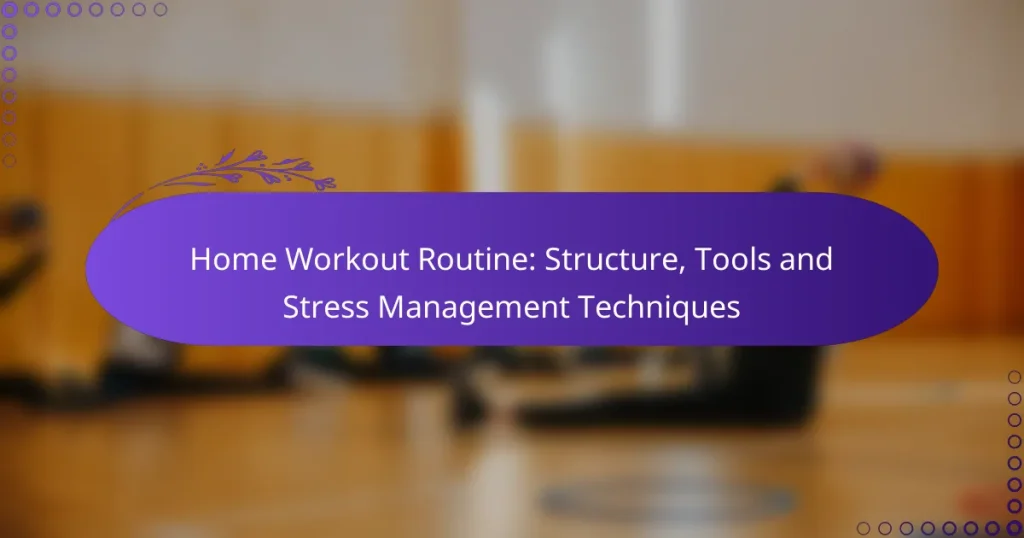Creating an effective home workout routine involves a balanced approach that includes strength training, cardio, and flexibility exercises tailored to your personal goals and available equipment. Essential tools like dumbbells, resistance bands, and yoga mats can enhance your fitness experience, while incorporating stress management techniques such as mindfulness and breathing exercises can help you stay focused and relaxed during your workouts.

How to create an effective home workout routine?
To create an effective home workout routine, focus on a balanced mix of strength training, cardio, and flexibility exercises. Tailor your plan to fit your goals, schedule, and available equipment, ensuring it remains enjoyable and sustainable.
Include strength training exercises
Strength training is essential for building muscle and increasing metabolism. Incorporate exercises like push-ups, squats, and lunges, which can be performed with minimal or no equipment. Aim for two to three sessions per week, targeting all major muscle groups.
Consider using resistance bands or dumbbells to add variety and intensity. A good rule of thumb is to perform 8-12 repetitions for each exercise, adjusting weights as needed to maintain proper form.
Incorporate cardio workouts
Cardio workouts improve heart health and burn calories. Activities such as jogging in place, jumping jacks, or dancing can be easily done at home. Aim for at least 150 minutes of moderate aerobic activity each week.
Mix high-intensity interval training (HIIT) with steady-state cardio for optimal results. For example, alternate between 30 seconds of high-intensity effort and 1 minute of lower intensity for a balanced approach.
Set a consistent schedule
Establishing a consistent workout schedule helps build a habit and keeps you accountable. Choose specific days and times for your workouts, treating them as important appointments. This consistency can significantly improve adherence to your routine.
Consider using reminders or a calendar app to help you stay on track. If you miss a workout, don’t be too hard on yourself; just get back to your schedule as soon as possible.
Utilize bodyweight exercises
Bodyweight exercises are a convenient way to build strength without equipment. Movements like planks, burpees, and mountain climbers can be performed anywhere and are effective for all fitness levels. They also help improve balance and coordination.
Incorporate a variety of bodyweight exercises into your routine to keep it engaging. Aim for a circuit of 5-10 different exercises, performing each for 30-60 seconds with short rest intervals in between.
Track progress with apps
Tracking your progress can enhance motivation and help you stay focused on your fitness goals. Use fitness apps to log workouts, monitor improvements, and set new challenges. Many apps offer features like workout reminders and progress charts.
Choose an app that suits your needs, whether it’s for tracking strength training, cardio, or overall fitness. Regularly reviewing your progress can provide insights into what’s working and where adjustments are needed.

What tools are essential for home workouts?
Essential tools for home workouts include equipment that enhances strength, flexibility, and overall fitness. Key items like dumbbells, resistance bands, yoga mats, fitness trackers, and online workout platforms can significantly elevate your home exercise experience.
Dumbbells for strength training
Dumbbells are versatile tools that allow for a wide range of strength training exercises. They come in various weights, typically ranging from 1 kg to 30 kg or more, making them suitable for beginners and advanced users alike.
When selecting dumbbells, consider adjustable options for space-saving and cost-effectiveness. Aim for a set that allows you to gradually increase weight as your strength improves.
Resistance bands for versatility
Resistance bands are lightweight, portable, and offer a unique way to incorporate resistance into your workouts. They come in different thicknesses, providing varying levels of resistance, which can be used for strength training, stretching, and rehabilitation.
To maximize their utility, look for bands with handles or anchors for added versatility. They are ideal for full-body workouts and can easily be stored in a drawer or bag.
Yoga mats for comfort
A good yoga mat provides cushioning and stability during workouts, especially for floor exercises and yoga. Mats typically range from 4 mm to 10 mm in thickness, with thicker mats offering more comfort.
When choosing a mat, consider materials that provide grip and durability. A non-slip surface is essential for maintaining balance during various poses and exercises.
Fitness trackers for monitoring
Fitness trackers help monitor your activity levels, heart rate, and calories burned, providing valuable insights into your workouts. Many models offer features like step counting, sleep tracking, and workout reminders.
Choose a tracker that fits your lifestyle and workout preferences. Look for compatibility with apps that can help you analyze your progress and set fitness goals.
Online workout platforms like Peloton
Online workout platforms, such as Peloton, provide access to a variety of classes ranging from cycling to yoga, often led by professional instructors. These platforms typically offer live and on-demand sessions, catering to different fitness levels.
When selecting a platform, consider subscription costs and the variety of classes offered. Many platforms also provide community features, which can enhance motivation and accountability.

How to manage stress during home workouts?
Managing stress during home workouts involves integrating techniques that promote relaxation and focus. By incorporating mindfulness, breathing exercises, and other calming practices, you can create a more enjoyable and effective workout experience.
Practice mindfulness techniques
Mindfulness techniques help you stay present and focused during your workouts, reducing anxiety and enhancing your performance. Simple practices like body scanning or focusing on your breath can ground you in the moment.
Try setting aside a few minutes before your workout to meditate or visualize your goals. This can help clear your mind and prepare you for the physical activity ahead.
Incorporate breathing exercises
Breathing exercises are essential for managing stress and improving your workout efficiency. Techniques such as diaphragmatic breathing can help lower your heart rate and promote relaxation.
Before starting your routine, take a few deep breaths, inhaling through your nose and exhaling through your mouth. Aim for a count of four on each inhale and exhale to establish a calming rhythm.
Use calming music
Listening to calming music can significantly enhance your mood and reduce stress during workouts. Choose tracks with a slow tempo and soothing melodies to create a peaceful atmosphere.
Consider creating a playlist of your favorite calming songs, or explore genres like ambient or acoustic music. This can help you maintain focus and enjoy your exercise routine more fully.
Set realistic fitness goals
Setting realistic fitness goals is crucial for managing stress and maintaining motivation. Goals should be specific, measurable, achievable, relevant, and time-bound (SMART) to ensure they are attainable.
For instance, instead of aiming to lose a specific number of pounds, focus on committing to a certain number of workouts per week. This approach can help you celebrate small victories and reduce feelings of overwhelm.
Engage in post-workout stretching
Post-workout stretching is an effective way to relieve tension and promote relaxation after exercising. Incorporating stretches can help your body recover and reduce muscle soreness.
Spend 5-10 minutes stretching major muscle groups after your workout. Focus on slow, controlled movements and deep breathing to enhance the calming effects of your routine.

What are the prerequisites for starting a home workout?
Before starting a home workout, it’s essential to assess your current fitness level, consult with a healthcare provider, and gather the necessary equipment. These steps ensure that your workout routine is safe, effective, and tailored to your needs.
Assess current fitness level
Understanding your current fitness level is crucial for designing a suitable workout plan. Consider factors such as your strength, endurance, flexibility, and any previous exercise experience. You can perform simple self-assessments, like timed exercises or basic strength tests, to gauge where you stand.
Based on your assessment, set realistic goals that align with your fitness level. For instance, if you’re a beginner, aim for shorter, less intense workouts, gradually increasing duration and intensity as you progress.
Consult with a healthcare provider
Before starting any new workout routine, especially if you have existing health conditions or concerns, consulting with a healthcare provider is advisable. They can provide personalized recommendations and help identify any limitations you should consider.
A healthcare provider may suggest specific exercises or modifications to accommodate your health status. This step is particularly important for individuals with chronic illnesses, injuries, or those who have been inactive for an extended period.
Gather necessary equipment
Having the right equipment can enhance your home workout experience. Basic items include a yoga mat, resistance bands, dumbbells, or kettlebells, depending on your fitness goals. You don’t need to invest heavily; many effective workouts can be done with minimal or even no equipment.
Consider your workout space and storage options when selecting equipment. For example, if you have limited space, opt for versatile items like adjustable dumbbells or resistance bands that can be easily stored away when not in use.


